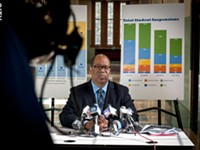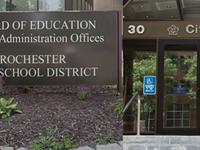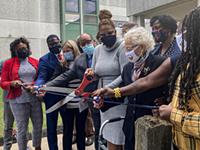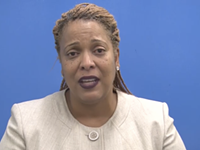Friday, September 27, 2013
School officials blame student behavior, not transporation for problems on East Main Street
Posted By Tim Louis Macaluso on Fri, Sep 27, 2013 at 11:04 AM
The large numbers of young people hanging out on East Main Street between bus transfers and getting into fights has certainly gotten City Hall’s attention. Though it’s still not clear whether a city school student fired the shot at the Liberty Pole last Monday, it couldn’t have happened at a worse time. Downtown business leaders are already anxious about the possibility of City Council President Lovely Warren succeeding Tom Richards as mayor, and what that will mean to downtown development. And the Fringe Festival, a major week-long downtown attraction, is under way.
The whole affair has put the city school district on the defense once again.
Richards says that safely transporting students to and from school is the district’s responsibility. School officials agree, but say that the problem with students on East Main Street is about bad behavior, not transportation. And that makes finding a solution a lot more complicated.
“We want to try and correct the behavior of some students,” one school official sats. “But there is a danger here of creating an attitude of ‘not wanting those kids downtown.’ And they have the right to be there.”
But solving the behavior problem may start with transportation. The district spends roughly $60 million annually to transport students. A portion of the money goes to a contract between the district and RTS, which allows mostly high school students to use a pass to freely access the buses. About 75 percent of the students who leave school to go home are diverted away from East Main Street, says the official.
That doesn’t mean, however, that they can’t use the pass to come back to East Main Street. Most of the students are dropped off at Stone Street, but they walk up to the Liberty Pole, creating what looks like a wall of teens from about 3:15 p.m. to 4:15 p.m.
But the official says that the crowd is much smaller than it seems. About 2,500 students could be in the East Main Street corridor during that time, he says, but most get off one bus to transfer to another.
But there are some glitches that RCSD and RTS are working on correcting that could be announced as soon as next week. Normally, the bus passes involve a photo ID. This school year, they didn’t, which has allowed students to lend the passes to other students.
Also, the passes permit students to move about in the system fairly freely until early evening. The RCSD wants newer digital passes that limit the hours of use, as well as what routes are available to students. And they will be digitally monitored.
School resource officers and school safety officers on East Main Street will play a key role in monitoring the students while they are downtown, but that is a temporary fix. And it’s a costly one, which concerns Superintendent Bolgen Vargas. School resource officers are Rochester police officers, and they will likely be working overtime.
“The superintendent is concerned that money that has to be diverted here [downtown security] isn’t going to instruction in the classroom where it’s needed,” says the official.
But improving behavior is going to be the district’s biggest challenge. The district is already wrestling with how to address behavior problems inside schools. The district’s data shows that there were about 5,500 suspensions during the last school year, and the majority was the result of disruptive behavior. And there’s some indications that the number isn’t reliable, and that it could be higher.
Vargas’s strategy for improving student achievement involves longer school days and making more extracurricular activities like sports, music, and drama available to city students. But his strategy is linked to a complex busing arrangement that could be compromised by more disturbances involving city students.
Vargas went down to the Liberty Pole earlier this week and talked to students, warning them that they would have to return to using the yellow school buses with the elementary children if their behavior doesn't improve. And that would greatly limit their access to libraries, city events, sports, and other activities.
Ultimately, improving student behavior both inside and outside school is going to require more help from parents, clergy, and the community, says the official. In the age of social media, which officials say has played a role in the disruptions, just steering kids away from East Main Street won’t achieve much.
The whole affair has put the city school district on the defense once again.
Richards says that safely transporting students to and from school is the district’s responsibility. School officials agree, but say that the problem with students on East Main Street is about bad behavior, not transportation. And that makes finding a solution a lot more complicated.
“We want to try and correct the behavior of some students,” one school official sats. “But there is a danger here of creating an attitude of ‘not wanting those kids downtown.’ And they have the right to be there.”
But solving the behavior problem may start with transportation. The district spends roughly $60 million annually to transport students. A portion of the money goes to a contract between the district and RTS, which allows mostly high school students to use a pass to freely access the buses. About 75 percent of the students who leave school to go home are diverted away from East Main Street, says the official.
That doesn’t mean, however, that they can’t use the pass to come back to East Main Street. Most of the students are dropped off at Stone Street, but they walk up to the Liberty Pole, creating what looks like a wall of teens from about 3:15 p.m. to 4:15 p.m.
But the official says that the crowd is much smaller than it seems. About 2,500 students could be in the East Main Street corridor during that time, he says, but most get off one bus to transfer to another.
But there are some glitches that RCSD and RTS are working on correcting that could be announced as soon as next week. Normally, the bus passes involve a photo ID. This school year, they didn’t, which has allowed students to lend the passes to other students.
Also, the passes permit students to move about in the system fairly freely until early evening. The RCSD wants newer digital passes that limit the hours of use, as well as what routes are available to students. And they will be digitally monitored.
School resource officers and school safety officers on East Main Street will play a key role in monitoring the students while they are downtown, but that is a temporary fix. And it’s a costly one, which concerns Superintendent Bolgen Vargas. School resource officers are Rochester police officers, and they will likely be working overtime.
“The superintendent is concerned that money that has to be diverted here [downtown security] isn’t going to instruction in the classroom where it’s needed,” says the official.
But improving behavior is going to be the district’s biggest challenge. The district is already wrestling with how to address behavior problems inside schools. The district’s data shows that there were about 5,500 suspensions during the last school year, and the majority was the result of disruptive behavior. And there’s some indications that the number isn’t reliable, and that it could be higher.
Vargas’s strategy for improving student achievement involves longer school days and making more extracurricular activities like sports, music, and drama available to city students. But his strategy is linked to a complex busing arrangement that could be compromised by more disturbances involving city students.
Vargas went down to the Liberty Pole earlier this week and talked to students, warning them that they would have to return to using the yellow school buses with the elementary children if their behavior doesn't improve. And that would greatly limit their access to libraries, city events, sports, and other activities.
Ultimately, improving student behavior both inside and outside school is going to require more help from parents, clergy, and the community, says the official. In the age of social media, which officials say has played a role in the disruptions, just steering kids away from East Main Street won’t achieve much.
Speaking of...
Latest in News Blog
More by Tim Louis Macaluso
-

RCSD financial crisis builds
Sep 23, 2019 -

RCSD facing spending concerns
Sep 20, 2019 -

Education forum tomorrow night for downtown residents
Sep 17, 2019 - More »




